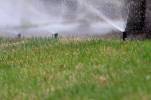Cold, wind can damage delicate queen palms
The arboretum at the University of Nevada, Las Vegas is sponsoring a spring gardening lecture series featuring local gardening experts. Lectures will be presented on Saturdays and Sundays throughout March in the Marjorie Barrick Museum, 4505 Maryland Parkway, which is located on the campus.
Additional information about the series can be obtained by calling the master gardener help line at 257-5555 or by contacting me at morrisr@unce.unr.edu.
Q: I have three queen palms around my spa. Two of the trees have very green fronds while the third one has yellowish fronds. They were all planted at the same time. They are all watered and fertilized the same. What could be the problem?
A: If the fronds are the newest fronds (in the center), this could be signaling a real problem. If they are older fronds, it may not be as critical.
It could be cold damage, drainage problems, damage from planting during cold temperatures or at the wrong time of year, or fertilizer problems.
Wind combined with low temperatures can be quite damaging. If they are protected from winds, they can handle cold temperatures more easily. Palms that have been in the ground and have gained some size will take colder temperatures better than newly planted palms.
First of all, never plant palms in the fall. This is the absolute worst time to plant them, unlike other plants. They like spring planting the best.
Make sure they are getting adequate irrigation. They should be getting 20-25 gallons per irrigation, but not be watered daily. At this time of year, weekly irrigations should be plenty, but they should be deep and long irrigations with time for the water to drain from around the roots before the next irrigation.
Palms do not like it if the soil becomes too dry, either. If you have to, use a moisture meter to help schedule the irrigations. Just leave it in the ground until you start to understand seasonal variations in your watering schedule.
This spring apply a complete fertilizer and iron. A palm fertilizer is fine, but you will still need to apply iron.
Surround the palms with organic mulch, not rock mulch.
Queen palms do not like wind very much and wind will make them look pretty bad because their fronds are relatively delicate compared to fan and date palms. Plant queen palms in protected areas, away from wind and low temperatures.
Humidity from a spa should help a bit, but it is not enough to overcome all of the obstacles of growing these palms in this climate.
If the center fronds are yellow, the center bud could be dying. There is not much you can do if this is the case. Keep the center of the palm where the bud is located as dry as you can. By this I mean avoid hosing off the palm so that the central bud gets wet. If the central bud dies, the palm is gone.
Q: Is there any problem leaving stakes on my trees after they have been planted? I have read that nursery stakes should be removed immediately and side stakes removed as soon as the trees are well rooted. They were planted about two years ago.
A: The reason staking is done is to keep the roots anchored in the ground, not to keep the entire tree from moving. If you feel the tree is not firmly anchored in the soil, then leave the stakes in but concentrate on having them removed by the end of the season.
During this time, encourage better rooting and anchoring by deep watering, watering less often and moving your sources of water further from the trunk. One season of these irrigation practices should firmly anchor the tree if the roots are capable of growing deep and into the soil surrounding the root ball.
If, at the end of this season, you are still uncomfortable with removing the stakes, thin the tree canopy to allow for more air movement through it and so it will not act like a sail when strong winds occur. You would do this by removing entire branches selectively throughout the canopy. Do this at the end of the growing season around late September or early October, after the stakes are removed. At this time of year, the roots are still actively growing while top growth is pretty much done.
Bob Morris is an associate professor with the University of Nevada Cooperative Extension. Direct gardening questions to the master gardener hot line at 257-5555 or contact Morris by e-mail at extremehort@aol.com.























